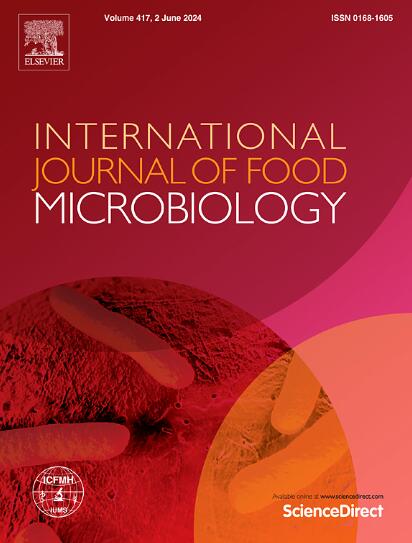Deciphering the biocontrol ability of Bacillus velezensis strains against phytopathogenic fungi in grapes by in situ and in silico approaches
IF 5.2
1区 农林科学
Q1 FOOD SCIENCE & TECHNOLOGY
International journal of food microbiology
Pub Date : 2025-06-10
DOI:10.1016/j.ijfoodmicro.2025.111317
引用次数: 0
Abstract
Bacillus species are promising biocontrol agents to confront the emergence of resistance to commonly used fungicides in agriculture. Control of Botrytis cinerea, Colletotrichum acutatum, and Aspergillus spp. is a great challenge, as these fungi negatively affect the quality and productivity of grapes. Furthermore, some Aspergillus species produce mycotoxins, which are regulated for grape products due to their toxic potential. In this study, four Bacillus velezensis strains were tested for controlling the growth of B. cinerea, C. acutatum, Aspergillus niger, Aspergillus westerdijkiae and Aspergillus flavus following in situ tests. Furthermore, an in silico approach was carried out to find genes associated with the antifungal activity of these strains. B. velezensis P1, P7, P11 and P45 demonstrated antifungal potential by inhibiting mycelial growth and spore germination, while also preventing the formation of reproductive structures in all fungi. The treatment of grapes with cell suspensions at 1.0 × 109 CFU/mL reduced the fungal colony count by at least 1 log CFU/g or caused complete inhibition, depending on the strain and fungus. Even when total suppression of fungal growth was not achieved, the biosynthesis pathways of ochratoxins and aflatoxins were disrupted. Co-inoculation of strains P1:P45 and P11:P45 was successfully proposed to ensure the absence of fungi in grapes. Genome analysis revealed six gene clusters associated with the production of antifungal compounds by Bacillus strains, such as fengycin, iturin/bacillomycin, surfactin, bacillaene, bacilysin, and bacillibactin. Therefore, these bacteria are promising in the biological control of fungi that cause severe damage in grape quality, reinforcing their potential as sustainable alternatives to chemical fungicides.
葡萄芽孢杆菌菌株对葡萄植物病原菌的生物防治能力的原位和计算机分析
芽孢杆菌是一种很有前途的生物防治剂,可以对抗农业常用杀菌剂出现的耐药性。葡萄灰霉病(Botrytis cinerea)、尖锐炭疽菌(Colletotrichum acutatum)和曲霉(Aspergillus spp.)的防治是一个巨大的挑战,因为这些真菌会对葡萄的品质和产量产生负面影响。此外,一些曲霉种类产生真菌毒素,由于其潜在的毒性,这些真菌毒素在葡萄产品中受到调节。本研究通过原位试验,研究了4株velezensis芽孢杆菌对灰绿曲霉、尖锐曲霉、黑曲霉、西部曲霉和黄曲霉生长的抑制作用。此外,采用计算机方法寻找与这些菌株抗真菌活性相关的基因。在所有真菌中,B. velezensis P1、P7、P11和P45通过抑制菌丝生长和孢子萌发,同时阻止生殖结构的形成,显示出抗真菌的潜力。1.0 × 109 CFU/mL的细胞悬浮液处理葡萄,真菌菌落计数至少减少1 log CFU/g或完全抑制,这取决于菌株和真菌。即使不能完全抑制真菌生长,赭曲霉毒素和黄曲霉毒素的生物合成途径也会被破坏。成功地提出了菌株P1:P45和P11:P45的共接种,以确保葡萄中没有真菌。基因组分析揭示了6个与芽孢杆菌菌株产生抗真菌化合物相关的基因簇,如fengycin、iturin/bacillomycin、surfactin、bacillaene、bacilysin和bacillibactin。因此,这些细菌在对葡萄质量造成严重损害的真菌进行生物防治方面很有前景,加强了它们作为化学杀菌剂的可持续替代品的潜力。
本文章由计算机程序翻译,如有差异,请以英文原文为准。
求助全文
约1分钟内获得全文
求助全文
来源期刊
CiteScore
10.40
自引率
5.60%
发文量
322
审稿时长
65 days
期刊介绍:
The International Journal of Food Microbiology publishes papers dealing with all aspects of food microbiology. Articles must present information that is novel, has high impact and interest, and is of high scientific quality. They should provide scientific or technological advancement in the specific field of interest of the journal and enhance its strong international reputation. Preliminary or confirmatory results as well as contributions not strictly related to food microbiology will not be considered for publication.

 求助内容:
求助内容: 应助结果提醒方式:
应助结果提醒方式:


